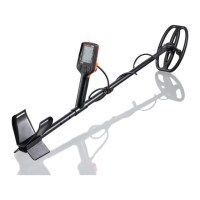4
Target Identification with the Quest X5
The X5 provides information on a target’s probable identification to help you determine if it is something you want to recover. When
a target is detected, the X5’s circuitry analyzes the signal and assigns a specific number ranging from 1 to 99 based on the target’s
conductivity. Objects made of iron tend to read at the lower end of that scale while targets made of copper and silver fall at the
upper end of the scale. The figure below shows where different targets fall on the 1-99 scale. As the coil passes over a target you will
receive an audio response which can also help identify targets based on the Audio option you have selected. This will be covered in
the Advanced Programming section of this manual. The Target ID # will appear in the center of the LCD display screen (see Area B on
the previous page) and the corresponding bar at the top of the screen will turn black.
NOTE: In areas containing trash and good targets, it is not always possible to reject all trash and only dig good targets. Target ID
accuracy will depend on the ground conditions, concentration of targets, external interference, target size & orientation as well as the
depth of the target. Testing known targets before you head out will help you understand how specific targets will register in terms of
their audio response and Target ID #. There will be a slight variation in Target ID #’s as you sweep back-&-forth across a target which
is normal; however, if the number fluctuates +/-20 or more, the detected target is typically trash. As you gain experience on actual in-
ground targets you will find that you are able to identify good targets with a high degree of accuracy.

